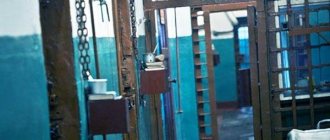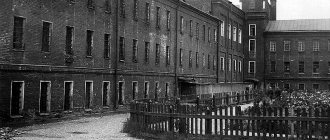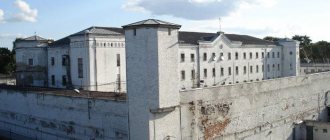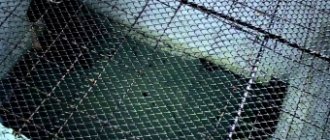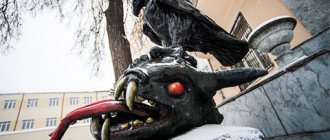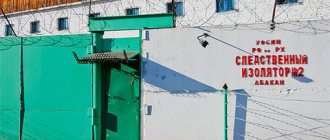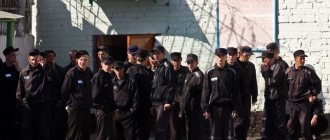In Russia, like in any other country, there is a long-established system of punishment. Those sentenced to real terms are placed in colonies, of which in our state, according to the Criminal Executive Code, there are several types. There are general, strict and special regime colonies, settlement colonies, medical correctional institutions, and educational colonies for minors.
The bulk of convicts end up in maximum security colonies, since such institutions contain adult citizens who have relapsed crimes and previously received a real sentence, as well as persons who have committed a particularly serious crime for the first time.
Maximum security colonies in Russia are legally defined in the Penal Code of the Russian Federation, which describes the features of serving the sentence. In particular, in each colony there are different conditions of detention: light, ordinary, strict and special (Article 123 of the Penal Code of the Russian Federation).
Normal conditions
Upon arrival at a correctional institution, the convict is placed in quarantine for 2 weeks while he is being processed, his character traits, possible diseases, etc. are identified. After this, the person sentenced to imprisonment is transferred to normal conditions, under which he can remain until the end of his term. They can be transferred to such a regime from strict conditions (if there are no penalties or violations) and from light conditions (if there are violations of the regime). Serving a sentence in this mode usually implies the following:
- long visits with relatives (up to 3 days) and short-term visits (up to 4 hours) - 3 times a year;
- transfers and parcels (up to 20 kg) and parcels (up to 2 kg) - 4 times a year.
What is it and how is it different from a colony?
A prison is a correctional institution designed to serve a sentence of imprisonment for the most dangerous criminals, whom the court has ordered to serve part of their sentence in this type of penitentiary institution. It also houses prisoners transferred from correctional colonies for violating the regime.
Prisons house only men. Both men and women are sent to colonies (if we are not talking about strict and special regime colonies).
There are only 2 regimes in prisons, and each prisoner starts with a strict one, in accordance with Article 130 of the Penal Code of the Russian Federation. After at least a year, subject to good behavior, it is possible to transfer to general. Colonies, in turn, have several regimes (strict, general, special, enhanced) and different conditions within each (regular, lightweight, strict). Sentencing for detention under one regime or another depends on the severity of the crime committed.
Those who have committed a particularly serious crime under Articles 205 - 205.5, 206, 208, 211, 220, 221, 277 - 279, 281, 317, 360, 361 are sentenced to serve part of their prison term. Among such crimes are terrorist acts , hostage taking, encroachment on the lives of public figures, some crimes against the government and some others.
Based on the Federal Law of December 27, 2018 N 516-FZ “On Amendments to the Criminal Executive Code of the Russian Federation in connection with the adoption of the Federal Law “On Amendments to Articles 58 and 72 of the Criminal Code of the Russian Federation”, it is impossible to transfer convicts from prison to correctional colony for the commission of crimes provided for in articles 205, 205.1, 205.3, part one of article 205.4, article 205.5, parts two - four of article 206, article 208, parts two - four of article 211, articles 277 - 279, 281, 317, 361 of the Criminal Code RF.
Also in prison may be those who were assigned to a correctional colony as punishment, but they were transferred to prison to do chores.
People are sent to correctional colonies of different regimes depending on the crime committed. Particularly dangerous repeat offenders and lifers are kept in the special regime penal colony (RF Penal Code Art. 124). Those convicted for the first time for especially serious crimes, as well as repeat offenders, are imprisoned in a maximum security penal colony (RF Penal Code Art. 122).
The range of articles for which they fall into the general regime penal code is wide. As a rule, these are those who have committed a serious offense for the first time. They are sent to colony settlements for unintentional crimes, as well as offenses of medium and light gravity committed for the first time (Penal Code of the Russian Federation Art. 128).
Prison prisoners are kept in locked general cells or in solitary confinement in special cases. Prisoners of the colony live in dormitories, except for prisoners sentenced to life imprisonment, for whom cells are assigned, just like in a prison, but their occupancy is maximum 2 people.
Differences in conditions of detention in prison and in a colony depend on the regimes and the established conditions within each regime (they can be light, strict, special).
So, in a maximum security prison, a walk lasts 2 hours, 2 short and 2 long visits, 2 parcels and 2 parcels are allowed per year. You can also spend 7,200 rubles monthly from your personal account. Under maximum security in prison, walks are reduced to 1.5 hours, there is one less long visit, one less parcels and packages per year. The amount that can be spent from the reserves of a personal account is also less - 6,000 rubles (Ukrainian Code of the Russian Federation Art. 131).
The conditions of stay in the penal colony are easier in comparison with those described. Similar or more severe conditions with the general prison regime are available in the special regime of the penal colony and in the strict regime of the penal colony under strict conditions. If we compare the strict regime of a prison, then only the strict conditions of the special regime of a colony are close to it.
If we are talking about a colony-settlement, then here the prisoners have the opportunity to move freely, at least within the confines of a secure facility (Penal Code of the Russian Federation, Art. 129). For prison and any other prison, free movement is excluded.
Lighter conditions
If the prisoner does not violate the regime of a maximum security colony, by order of the head of the colony, he can be transferred to lighter conditions of detention. They imply more comfortable living in a colony compared to the previous regime, when convicts are in a dormitory.
For visits and transfers under easier conditions, the following procedure is assumed:
- long visits, short visits – 4 times a year;
- transfers and parcels, parcels – 6 times a year.
Regime of special conditions in a correctional colony
Correctional institutions have a system of rights, responsibilities, and permissions. For prisoners, these rights are severely limited, however, while remaining human, they retained a minimum list of permissions.
Prisoners under general conditions of detention are allowed to:
- waste of funds received from the state. benefits earned or received by transfer to a personal account (no more than 7,200 rubles);
- make appointments, no more than three short and three long ones per year;
- receive three small and three large parcels per year.
Convicts in light conditions have the right to:
- waste of funds received from the state. benefits earned or received by transfer to a personal account (no more than 7,800 rubles);
- make appointments, no more than four short and four long ones per year;
- receive four small and four large parcels per year.
Persons in lighter conditions live in prison dormitories.
The list of goods permitted for purchase by prisoners is uniform. These include:
- food;
- things (items) of prime necessity;
- legal services;
- visiting a hairdresser;
- medical consultation (prescription of treatment).
Prisoners transferred to maximum security conditions have the right to:
- Spending money received from the state. benefits earned or received by transfer to a personal account (no more than 6,600 rubles).
- Make appointments, no more than two short and one long per year.
- Receive one small and one large parcel per year.
- Walk no more than an hour and a half every day. In the absence of offenses and disputes with superiors, the walk can be extended to three hours.
Walking is permitted for all persons in custody, with the exception of those under the sanction of a punishment cell.
Strict conditions
There are also strict conditions to which a convicted person can be transferred by order of the head of the colony if the regime of the maximum security colony is violated. Criminals are kept in closed premises with the possibility of a daily walk lasting about two hours in a separate area.
For such violators of the law, the following procedure for visits and transfers is provided:
- long visits – once a year;
- short-term visits, transfers and parcels, parcels - 2 times a year.
As can be seen from the above, the stricter the conditions of detention, the fewer visits and transfers the convict is entitled to, that is, he is significantly limited in constant communication with close people and relatives, as well as in receiving basic necessities and food “from the outside.”
What is a special regime?
The special regime in the colonies differs significantly from the general and strict regime. It can be of three types:
- lightweight;
- ordinary;
- strict.
They differ in:
- The amount of money prisoners can spend on personal needs.
- The number and duration of dates, the size of parcels.
For the first 10 years, convicts are kept under strict conditions, then they are transferred to ordinary conditions.
If the convicted person does not violate the regime, does not commit crimes, that is, behaves according to the rules, then he can qualify for a light regime.
It gives the right to spend 60% of the money from the account on personal needs, receive 4 parcels, parcels and deliveries annually, 4 short and 4 long dates throughout the year.
However, most of the convicts were disowned by all their relatives, so they receive neither parcels nor visits.
Under strict conditions, the offender is kept in solitary confinement. He is entitled to 2 short visits, which take place in a room with glass through which the convict communicates with relatives. You can also send just one transmission.
Cameras
Criminals are in cells of 2-3 people or alone. Those who pose a danger to fellow inmates and are prone to escape and attack the convoy live alone.
There are signs next to the bed and outside the cell describing the atrocities the prisoner has committed. This is done to ensure that the staff does not develop sympathy for the criminal.
Assignment to cells in the zone is based on psychological compatibility. Usually pedophiles and maniacs sit alone, since no one can withstand such proximity for more than 2-3 days.
The cells contain metal beds, chairs and tables bolted to the floor (see photo). During the day, it is forbidden to sit, much less lie on the bed; you can only sit on chairs.
The convicts sleep, facing the door, in the light. You can’t turn your back to the wall or cover your head with a blanket. If one person violates the rules, then everyone who sits in that cell is responsible.
Also, people are required to wear only prison uniform; wearing anything else is strictly prohibited.
The windows in the rooms are located high, so people cannot see daylight. They are under 24-hour video surveillance.
Searches are carried out every 15 minutes, for this purpose the prisoner puts his hands through the window to put on handcuffs. Then he is taken out into the corridor in a bent position. For each convict there are 3 employees with a dog.
Walking takes place in a special small room where air enters only from above. Movement around the colony is only possible with a blindfold, accompanied by guards with dogs. Some establishments are allowed to work.
Criminals work in separate cells of 1-2 people.
There they can paint pictures, carve wood, sew mittens, etc.
For this they are entitled to a salary, which almost entirely goes towards compensating the victims.
There are no cultural events. You are allowed to watch movies occasionally for special merits. Any communication between inmates is also excluded. Self-study is possible, but you cannot officially enter educational institutions.
The colonies have libraries with predominantly religious literature and chapels. The priest regularly visits convicts with sermons. Almost 90% of criminals begin to believe in God.
Daily regime
The prisoners' morning begins at 6.00. Half an hour is given to make the bed and toilet. Then breakfast time begins. It is served directly into the cells through the window. After breakfast, some go to work, the rest stay in their cells. They can read books, listen to the radio.
Lunch starts at 12. Before this, the cells are searched and prisoners are asked for complaints. After eating, you can also write letters and read. Walk for about 45 minutes in a special room.
At 7 o'clock there is dinner.
Lights out at 22:00, after which movement in the cells is prohibited, with the exception of visiting the toilet.
Once a week, criminals are taken to the shower.
They are led to the shower room in handcuffs, then through the window the guard removes the handcuffs. Washing usually lasts 45 minutes. When necessary, a barber comes to cut the prisoners' hair.
If any health problems occur, the person is examined by a prison doctor. Every year, prisoners undergo fluorography and, if necessary, visit a dentist.
If a criminal is diagnosed with tuberculosis, HIV or hepatitis, they receive free treatment from the state. Every year, up to 900 thousand rubles are spent on 1 such patient.
Examination by a doctor is also carried out through the bars. If necessary, a course of treatment with tablets or droppers is prescribed. If there is a serious threat to the health of the patient, he is transferred to the medical unit.
When a prisoner dies, his relatives are notified. If they don't claim his body within 10 days, he is buried in a cemetery. Subsequently, relatives can carry out reburial.
Usually people live in special regime for 7-10 years, but there are those who stay there much longer. Some cannot stand it and commit suicide.
Special conditions
In the event of a significant violation of the containment regime, management may decide to create special conditions of detention. This type of serving a sentence usually involves placement in a cell-type room, where the prisoner is kept in the strictest conditions possible. The convicted person has the right to receive two parcels or packages per year, and short visits every six months. These are the general rules for serving a sentence in a cell. They may differ in each colony.
High security infrared in Russia list
Since the Constitutional Court introduced a ban on the death penalty, people who have committed particularly serious crimes have been sentenced to life imprisonment. The prisons in which they are kept have a special status and are distinguished by an extremely strict regime of detention.
Since the moratorium was introduced, the number of colonies housing life-sentence prisoners has increased. ... Dear readers! Our articles talk about typical ways to resolve legal issues, but each case is unique. If you want to find out how to solve your particular problem, please contact the online consultant form on the right or call +7 (499) 703-51-67. It was at that time that a single cell-type room (EPKT) was created here, intended for the re-education of “thieves in law” - the highest authorities of the criminal world. It was at that time that a new method of combating the prison hierarchy was first invented. “Thieves in law” were specially isolated from other castes and deprived of the society of “sixes”. As a result, the authorities had to constantly be only with their own kind and find out which of them was more important. If you believe the legends, at that time about 130 representatives of the criminal “authorities” lost their “crowns” in the “White Swan”. At the same time, rumors spread throughout the country that the city of Solikamsk (Perm Territory) was not at all the best place to serve another term. Why "swan"? Legends and facts All special regime correctional institutions operating today have original informal names. FBU IK-2 is no exception.
> Russian prisons. There's no turning back
What caste can pedophiles be in and how do they “sit”?
Special regime colonies
It is necessary to say about such a correctional institution as a maximum security colony. In fact, the correct name for such facilities is a special regime colony. In these IR conditions, the conditions of detention are much different. This is due to the fact that they contain dangerous repeat offenders or those sentenced to life imprisonment. Women cannot be transferred to special treatment.
Thus, this type of colony is inhabited by especially dangerous criminal elements. A maximum security men's colony (as well as special and general) contains within its walls prisoners with different tendencies: escape, suicide, malicious violation of the regime and attacks on employees (and cellmates). In the special regime “camp” there are “supervisors” who oversee compliance with their own criminal regime of relations between convicts, which, as a rule, contradicts the rules of the penal system.
List of the most famous prisons in Russia:
Federal government prison-type institutions No. 1 of the Federal Penitentiary Service for the Vladimir Region
600120, Vladimir region, Petushinsky district, Pokrov, st. October Revolution, 75-A, tel.: 8 (49243) 6-72-70. General and strict regimes.
The prison was founded in 1822 as Pokrovsky Prison Castle . Later - Pokrovskaya transit prison. Initially it functioned as a medical and labor clinic. Since the early 1960s, a specialized prison for tuberculosis patients.
Convicts who are in prison and have tuberculosis are serving their sentences. Among the prisoners are dangerous criminals, repeat offenders from all over the country.
No. 2 in the Vladimir region (“Vladimir Central”)
600020, Vladimir region, Vladimir, st. Bolshaya Nizhegorodskaya, 67 tel. General and strict regimes.
Conditions of detention were tightened during the years of the first Russian Revolution . There were frequent cases of attacks on employees, including the heads of detachments, fights between cellmates with sharpeners in their hands, and deaths of prisoners.
Founded in 1783 as a workhouse for those convicted of minor crimes. Since 1838 - a prison company. Since 1906, a temporary convict prison for political prisoners, immediately after the revolution - Vladgubispravdom, since the early 1920s - the Vladimir political detention center, then TON (special purpose prison).
They go to prison for serious or especially serious criminal acts . Famous prisoners: State Duma deputy Vasily Shulgin, who accepted the abdication of the throne from Nicholas II, singer Lidia Ruslanova, actress Zoya Fedorova, Vasily Stalin.
FKU "Prison of the Federal Penitentiary Service of Russia in the Krasnoyarsk Territory"
662606, Krasnoyarsk region, Minusinsk, st. Gorky, 114 tel.: 8 (39132) 2-59-82. General and strict regimes.
Prisoners are “broken” through physical violence against them . There are also cases of death among those prisoners who were preparing for imminent release.
Particularly dangerous criminals are kept. The crime boss Ruslan Gegechkori (Shlyapa Mladshiy), Aslan Cherkesov, and Chechen businessman from Khakassia Abdul Isaev served their sentences here.
No. 2 GUFSIN of Russia for the Krasnoyarsk Territory
663180, Krasnoyarsk region, Yeniseisk, st. Dekabristov, 11 tel.: 8 (391-95) 2-46-92. General and strict regimes.
In the 17th century, torture and executions were carried out here in a special courtyard , including by burning at the stake. In the 50s of the 20th century, death sentences passed by the court were also carried out here.
They hold life prisoners who have committed serious or especially serious crimes : child killers, terrorists, serial maniacs, even cannibals.
Archpriest Avvakum, leader of the Socialist Revolutionary Party Gershuni, Joseph Stalin (1913), and Archbishop Luka (Voino-Yasenetsky) served their sentences here.
FKU "Prison of the Federal Penitentiary Service of Russia in the Saratov Region"
412315, Saratov region, Balashov, st. Uralskaya, 17. Tel.: 8 (84545) 6-32-72. General and strict regimes.
In the 30s of the 20th century, executions were carried out in the Balashov prison under Art. 58. In the 1980s, there were frequent prison riots here, after which prisoners were severely beaten.
Established in 1837 as the Balashov district prison . The stone one-story building was built after a fire in a wooden structure. At the beginning of the 19th century, a new four-story stone building was built.
They are caught for especially serious crimes (robberies, robberies and murders) and in case of a particularly dangerous recidivism of the crime, as well as for violating the order by transferring from the penal colony. Pyotr Ionovich Yakir (historian, dissident) sat here.
FKU "Prison of the Federal Penitentiary Service of the Ulyanovsk Region"
433513, Ulyanovsk region, Dimitrovgrad, st. Kalugina, 66 tel.: 8 (84235) 9-34-61. General and strict regimes.
It has existed since 1896 as a house of arrest, after the revolution - the Melekessky district house of detention. Since 1937 - Prison No. 4, since 1964 - Pre-trial Detention Center No. 2, since 1987 - Prison. They go to prison for especially serious crimes . Among the prisoners are terrorists, thieves in law and gang leaders, active members of gangs and members of organized crime groups.
FKU "Prison of the Federal Penitentiary Service of Russia in the Chelyabinsk Region"
457670, Chelyabinsk region, Verkhneuralsk, st. Severnaya 1 tel.: +7 (35143) 2-13-98,. General and strict regimes.
The cruelties of the prison are associated with the legend of the royal punishment cell, which is located in the basements of this prison-fortress. The punishment cell is supposedly an endless labyrinth from which there is no way out. It was there that the most dangerous prisoners were sent, and they wandered here until their deaths.
Created in 1914. At different periods of time, the prison was closed and then reopened . In 1966, ITK-13 was created on the basis of the prison. In 1972 the prison was restored. Those who served their sentences were Zinoviev, Kamenev, Radek, the first editor of Komsomolskaya Pravda Slepkov, Hitler's sister M. Koppesteiner, diplomat Raoul Wallenberg, Fanny Kaplan, Metropolitan Krutitsky.
In defense of the convicted
But you shouldn’t think that absolutely all convicts are only thinking about maliciously violating the regime of a maximum security colony or attacking someone. There are citizens who commit crimes due to life circumstances, simply because they have not learned to exist differently. Many words have been said about this, in particular, about the fact that the entire penitentiary system of Russia is not suitable for the true correction of convicts, and public rejection of former prisoners prevents even an attempt by a stumbled person to start a new life from scratch.
Society itself, complaining about the behavior of criminals, convicted and already released, pushes them to commit new illegal acts, considering such citizens “the scum of society.”
What are the types of colonies and who is sent to them?
According to Art.
74 of the Criminal Executive Code of the Russian Federation, adult convicts serve sentences of imprisonment in colonies. These institutions are divided into settlement colonies, general, strict and special regime correctional colonies. The type of correctional colony in which the convicted person must serve his sentence is determined by the court. In general regime colonies, first-time convicted citizens who have committed a serious crime, as well as careless or intentional crimes of minor or moderate gravity, serve their sentences, unless the court sends them to a settlement colony.
Maximum security correctional colonies house men who have been convicted for the first time of committing particularly serious crimes. Male recidivists who have previously served imprisonment are also placed there.
Men who have had a particularly dangerous relapse into crime, as well as those sentenced to life imprisonment, serve their sentences in special regime colonies.
In correctional colonies of general, strict and special regime, there are three types of conditions for serving a sentence: ordinary, light and strict. In normal and light conditions, convicts live in dormitories, in strict conditions - in locked rooms. Prisoners serving life sentences are kept only in cells, usually of no more than two people. Depending on the type of colony and conditions of detention, convicts have the right to a varying number of visits with loved ones, telephone calls, parcels and parcels.
Women in the Russian Federation can serve their sentences in general regime colonies, as well as in settlement colonies.
Minors or convicts left there until they reach the age of 19 serve their sentences in educational colonies. Also, in such colonies there may be isolated areas that function as general regime correctional colonies; they contain prisoners who turned 18 years old while serving their sentences.
How is a prison different from a colony?
In colloquial Russian speech, the word "prison" is often used to refer to any institution in which convicted persons serve a sentence of imprisonment. However, according to the Criminal Executive Code (EC) of the Russian Federation, a prison is a separate type of correctional institution.
Those who have been sentenced to imprisonment for a term of over five years for committing especially serious crimes, as well as for individual crimes such as terrorism, hostage-taking, organizing an illegal armed group, hijacking an aircraft, train or water vessel, are placed in prisons. authorities. Prisons also house particularly dangerous repeat offenders and those who were transferred from correctional colonies for malicious violation of the order of serving their sentences.
Prisoners are kept in locked general cells and, in special cases, in solitary confinement. As a rule, a prison is a separate building or a complex of buildings, while a colony occupies a large area with industrial premises and a residential area; on the territory of the colony there may be a store, a club, a library, a school and even a football field.
What is a pre-trial detention center and who is kept in it?
Pre-trial detention centers (SIZOs) are primarily used to hold suspects and accused persons against whom detention has been applied as a preventive measure. Those. Those who are under investigation and awaiting trial or are on trial are placed in pre-trial detention centers.
Detention centers in some cases also serve as correctional facilities. They contain convicts left there to perform household maintenance work, and convicts who are to be sent to correctional institutions to serve their sentences after the court verdict has entered into legal force. Also, convicts are admitted to pre-trial detention centers during their transfer from one place of serving their sentence to another.
Labor of convicts
In colonies, convicts, as a rule, are engaged in socially useful labor, that is, they work and receive wages for it. The regime of a maximum security colony provides for any types of activities that are permitted by law and provided for in this IC. The money earned is credited to the account of the convicted person minus the amount for the claims of the victims, if any. Also, prisoners can receive pensions and other social benefits at their location, if they are provided for convicted prisoners. Products manufactured in the IC are sold under general business conditions. The entire working period is included in the prisoner’s total length of service and is taken into account when calculating the pension.
Special regime - the highest measure of criminal punishment in the Russian Federation
During the period of the moratorium on the death penalty, the most severe sentence for a criminal in Russia is to serve the sentence in a special regime colony. In such penal colonies, prisoners are kept in extremely harsh conditions:
- in solitary confinement or in cells for a maximum of 2–4 people;
- with additional bars separating windows and doors in cells;
- in conditions of constant lighting under video surveillance 24/7;
- without the right to communicate with cellmates;
- subject to the requirement of moving around the prison in a bent position, handcuffed behind the back, under escort of several guards and a dog handler with a dog;
- in conditions of limited walks in a closed courtyard, deprived of sunlight;
- in complete isolation from prison society (even special regime prisoners work in the workshops of their own building, a maximum of three people each);
- without the right to correspondence and visits during the first 10 years of imprisonment.
Mainly those who received life sentences are kept in special regime colonies: serial maniacs and murderers, cannibals, terrorists, founders of organized criminal groups (OCGs). This also includes former residents of general and strict regime penal colonies who committed serious crimes while serving their sentences.
What is a special security prison?
To understand in detail the concept of a special regime prison, you need to define the concept of a special regime colony. Firstly, it is an institution of the penitentiary system that isolates the most dangerous criminals, repeat offenders sentenced to life imprisonment.
There are several conditions of detention in the colony - normal conditions, light conditions and strict conditions.
Prisoners who do not belong to the category of “death row” or life-sentenced prisoners are assigned to normal conditions.
The difference between the modes is not particularly significant; only some restrictions stand out. The limitation is how much money a prisoner can spend from his personal account (no more than 30% of the minimum wage), and a limit is also set on parcels, parcels and visits (4 visits per year).
Important! It is allowed to incentivize prisoners for exemplary behavior throughout the year. In this case, those convicted can count on a relaxation of prohibitions.
The light regime implies a change in the amount that a prisoner can spend from his personal account (up to 60% of the minimum wage), and the number of parcels and visits also increases. But, despite this, along with the normal and light regime there are also strict conditions. In this case, prisoners are kept in specially equipped rooms, two people per cell.
There are cases when a prisoner is transferred from a light regime to a strict regime for violating prison rules.
In a special regime colony there are criminals who have received the maximum term of imprisonment.
Distinctive features of the KSR from prisons
A correctional colony is a place of mass isolation of citizens who have received convictions for various criminal acts. Prisoners are kept in a common area of 2 square meters. m for each inhabitant.
Often people call them “zones”, because the territory is conditionally zoned, and it includes the following areas :
- an industrial zone for criminals to carry out labor activities;
- residential area, including places of direct residence, eating, holding cultural events, training programs, and providing assistance;
- local part, designed for 200-600 people, used for walking.
What is the difference between a prison and a colony? The main difference is that in prison the possibility of moving people is minimal. That is, this is one or more buildings equipped with a line of defense and a particularly strict access control regime. Traditionally, the movement of people in prison is limited to short walks.
Attention! Unlike a colony, prisoners in prison do not have jobs, which forces them to while away their days doing nothing.
The only activity is periodic meetings with a lawyer. If we talk about any movement, it is carried out strictly under the control of security, and the territory itself is constantly monitored by competent employees.
Another difference is that a strict prison is represented by several buildings for various purposes. That is, it is a kind of town in which there is a special “infrastructure” available to persons serving sentences. Within the complex there may be areas for work activities, administrative premises, and shops.
Life in such conditions is almost no different from ordinary life in freedom, with the exception of general conditions and level of comfort. The goal is to correct the person who has stumbled and return him to his previous existence, but in freedom. People who have very little chance of reform are put in prison.
Despite the relative freedom of movement, special regime colonies in Russia have their own classification based on the level of strictness of the rules of detention. Thus, there may be correctional colonies of general, strict, special, or enhanced regime. Each of them implies its own framework and limitations. For example, only males who have encountered a crime for the first time in their lives are sent to a maximum security colony.
Why do they give such deadlines?
to special detention for the following offenses :
- Serial murders, rapes.
- Act of terrorism.
- Criminals sentenced to death sentence commuted to life imprisonment.
- Those who committed a particularly serious crime while they were serving their sentences in other colonies.
The following categories of persons cannot be sent to such institutions
- women>;
- minors>;
- men who were 65 years of age or older at the time of sentencing.
Settlements
In settlement colonies, prisoners can also work and study, only in a more free regime. The legislation provides for convicts to stay on the territory of the settlement with the right to travel to the city (since these institutions are located far from populated areas), if this is related to work and study. In addition, those serving their sentences have vacation and an unlimited number of visits with relatives and other people in the territory occupied by the correctional colony.
Strict security settlements are not defined as a category of colonies in the RF Penitentiary Commission, but they exist in the sense of the conditions in which convicts are found. In these institutions, the decisions of the chief, who sets the rules for the detention of convicts, are significant. Most often, a strict regime does not apply to the settlement as a whole, but to a separate category of citizens in the institution. As in all organizations of this type, in a colony of this type there are conditions of stay, which are mentioned above.
Convicts from other colonies may be transferred to settlements in connection with the replacement of the judicial detention regime.
List of institutions
Despite all the severity of the structure, institutions with a special regime of detention have very romantic names. In total, there are 7 similar prisons in the Russian Federation :
- Mordovian colony . It contains 200 people, most of them are serial killers and maniacs.
- Black Dolphin. Located in the town of the Orenburg region - Sol-Iletsk. The institution received such a beautiful name because of the figure of a black dolphin that the prisoners sculpted.
- Polar owl. Located above the Arctic Circle in the village of Kharp, where most of the year the temperature hovers around minus 40 degrees. There's no point in running away from here. The most famous prisoner is the Bitsa maniac A. Pichushkin.
- Black golden eagle . The institution is located in the very north of the Sverdlovsk region. The colony got its name when one of the criminals sculpted a sculpture of a black golden eagle holding a snake in its claws. The main contingent are maniac killers.
- White Swan. Located in Solikamsk. It is called so because the prisoners here move in the “swan pose”: leaning forward, raising their clasped hands behind their backs. The most famous “inhabitant” is the terrorist Salman Raduev.
- Vologda nickel .
It is located on an island, so escaping from here is impossible. Initially there was a monastery here, then the premises were converted into a prison. - Torbeevsky Central. Located in the Republic of Mordovia. Here the convicts sit for a certain time, then they are transported to other colonies.
Location of colonies
Often relatives of convicts have questions not only about the conditions of detention in any correctional institution, but also about its location. The list of maximum security colonies is quite extensive. In each federal district of Russia there are at least 30 such institutions, not counting colonies of other regimes, pre-trial detention centers and settlements. In some cases, these objects combine two modes: strict and residential, general and special, etc.
Addresses of maximum security colonies (some of them):
1. FKU IK-5 - village. Sosnovka, st. Litvinova, 104v, Belgorod.
2. FKU IK-3 - st. Polina Osipenko, 49, Vladimir.
3. FKU IK-2 - st. Eletskaya, 2, Livny.
4. FKU IK-6 - maximum security women's colony (1300 places) village. Shakhovo, Kromsky district.
5. FKU IK-10 “Vaskin Mokh” - village. Metallistov, p/o Mikhailovskoye, Kalininsky district.
6. FKU IK-19 - r.p. Markovo, Irkutsk district, Irkutsk region.
7. FKU IK-43 - st. Bakha, 3a, Yagunovsky settlement, Kemerovo.
8. FKU IK-2 - st. Tselinnaya, 50, Rybinsk, Yaroslavl region. and many others.
Most often these are remote areas of the city or populated areas. As a rule, the pre-trial detention center (pre-trial detention center), where the accused are kept during the investigation before sentencing, are located within the city. By the way, the conditions of detention in a pre-trial detention center are much worse than in maximum security and other regime colonies, therefore the following rule for calculating the term of punishment is recognized by law: 1 day in a pre-trial detention center is equivalent to 1.5 days in a colony. This is due to the fact that before a convicted person gets into the “zone”, he can be under investigation from several months to several years.
Guests from "Black Golden Eagle"
Residential block of the Snezhinki prison building. Photo: Website www.mzk1.ru
The insulator received its unusual name - “Snowflake” - due to the fact that its buildings are arranged in the shape of a seven-pointed star. The pre-trial detention center was inaugurated at the end of January 2015, although it was put into operation back in 2012. “Snezhinka” operated as a detention center for only two years, and its occupancy rate with prisoners never exceeded eight percent of all places. As a result, they decided to repurpose the unused pre-trial detention center into IK-6, a special regime zone for those sentenced to life terms.
Today “Snezhinka” is designed for 378 “life prisoners”, who can be accommodated in 144 cells; they are located in the second, third and fourth blocks of the zone. In fact, there are 250 life prisoners in IK-6. The first 23 of them arrived in Elban on September 20, 2022 - before that they were in the famous Black Golden Eagle colony in the Sverdlovsk region, which they decided to close.
The convicts were traveling in stages through the Irkutsk pre-trial detention center, and some of them, barely reaching Elban, hastened to write complaints about ill-treatment in the detention center. The prisoners were outraged that they were led around the territory of the Irkutsk detention center in handcuffs and with guard dogs. Those sentenced to life considered these measures unnecessary and even torture, because in the Black Golden Eagle they were distinguished by exemplary behavior. True, an audit carried out on the basis of complaints from convicts confirmed that all the security measures that were applied to prisoners in the pre-trial detention center were appropriate.
Special colonies and prisons
In Russia, in addition to the fact that the regime of a maximum security colony provides for slightly different conditions of detention from the general ones, these institutions also have a special reputation. In this regard, there are peculiar legends about correctional institutions. The most famous are the special regime colonies where death row prisoners are housed - those for whom the death penalty was replaced with life imprisonment, as well as pre-trial detention centers in different cities of Russia, which have their own special history.
Among such institutions we can name the famous Vladimir Central, Lefortovo Prison, Matrosskaya Tishina, Butyrskaya Prison, “White Swan”, “Black Dolphin”, Kresty. The stories told both within the walls of prisons and in freedom amaze even the most seasoned people with their content.
IR special regime in Russia list
The standard working hours, as well as safety precautions for prisoners, are the same as for ordinary workers. 4. 5. Maximum security colonies in Russia Wikipedia list A significant part of repeat offenders are people who not only have no family, but also no permanent place of residence. There are three to four times more prisoners without permanent residence than among the corresponding category of those convicted for the first time. 11. A convict named Bakhodir from the city of Bezhetsk. Convicted under Article 111, paragraph 4 (grievous bodily harm), served 6 of the 9 assigned years.
This is his second trip. His wife and seven-year-old daughter are waiting for him in freedom. In the colony, Bakhodir works as a welder and assembles boxes for cable installations for residential buildings.
12. 13. Worker's hands. 14. 15. 16. It got its name thanks to the sculptures of black dolphins with which the prison administration decorated the territory of the colony. Located in the Orenburg region. The regime is known for its harshness. Prisoners are not allowed to move around the territory of the colony without an escort of several FSIN employees, who are accompanied by a service dog. They wear a blindfold over their eyes, through which no light passes. There are two people in cells. Some particularly dangerous criminals are kept alone.
- Mordovian colony. As the name suggests, it is located in Mordovia. Accommodates about 200 people. The main population of prisoners are serial killers. One cell can accommodate up to four people. There is a church and a grocery store on the territory of the colony.
- White Swan. There are several versions about the origin of the name of the colony.
Regime of some Russian colonies
Unfortunately, some employees of the few remaining regime colonies continue to administer their own justice. At the moment, there are fewer and fewer such institutions, but they exist in every region of Russia. For example, relatives of convicts who are in IK-19 in the Irkutsk region speak extremely negatively about the conditions of their loved ones’ stay within the walls of this organization. The Irkutsk maximum security colony does not differ in population from others, but the procedures for communicating with prisoners leave much to be desired.
In the Kemerovo region in 2007, a scandal broke out over the attitude of LIU-16 employees towards sick prisoners, when convicts who were miraculously freed from the “death zone” spoke about the horrors that were happening within the walls of the institution with the permission of the administration.
At the same time, in the special regime colony IK-29 in Kemerovo, convicts can insure their life and health, thereby protecting themselves from attacks by FKU employees.
In the city of Rybinsk, the maximum security colony IK-2 “thundered” throughout the country with the events of mass suicides of pioneers (those who first entered the colony) in 2013.
At the same time, they began to take action against employees who commit illegal actions. According to the Federal Penitentiary Service, in March 2014, two correctional officers were detained while attempting to commit a crime. Unfortunately, the data has been removed from public access, only the header remains.
Drawing conclusions about the punishment system, regardless of the regime of the colony, we can say that significant changes need to be made. And it is not the RF PEC that needs to be changed, but the people who implement it. The health and lives of people who, even through their own carelessness, ended up in a colony depend on this.
Echoes of bloody showdowns
Criminal authority Stanislav Tishchenko. Photo: Website www.mzk1.ru
Each of those serving life sentences in Snowflake has a very dark past. For example, one of the oldest prisoners of IK-6, 75-year-old Stanislav Tishchenko, was previously imprisoned in the Black Dolphin colony in the Orenburg region. Tishchenko was there with his son Igor, and they ended up behind bars because of a gang war that occurred in 1996.
Then Igor Tishchenko opened fire at a kebab shop near Norilskaya Street in Moscow, and his father Stanislav threw a grenade at his opponents. Among those killed in the incident was thief in law Nikolai Akbashev, known in criminal circles as Akbashenok. For the attack in a kebab shop, father and son Tishchenko received life sentences.
Stanislav Tishchenko’s neighbor in “Snezhinka” Alexander Lozhkin is a participant in the most mass murder in the Middle Urals. It was committed in one of the saunas of Nizhny Tagil on the night of February 8, 1997: a party was being held there on the occasion of the birthday of one of the vacationers. As usual, there was some alcohol involved, and at some point a quarrel broke out in the sauna. During the ceremony, the birthday boy asked four guests to leave, one of whom was Lozhkin.
He was offended by such a disrespectful gesture, took out a gas pistol, which he himself converted into a combat pistol, and began to shoot. The three remaining guests, who were asked to leave the sauna, attacked their opponents with knives. As a result, eight people died, six of whom were killed by Lozhkin. In 2001, he received a life sentence, which he served in the Black Golden Eagle before Snezhinka.
